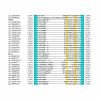Diversity in domain architectures of Ser/Thr kinases and their homologues in prokaryotes
- PMID: 16171520
- PMCID: PMC1262709
- DOI: 10.1186/1471-2164-6-129
Diversity in domain architectures of Ser/Thr kinases and their homologues in prokaryotes
Abstract
Background: Ser/Thr/Tyr kinases (STYKs) commonly found in eukaryotes have been recently reported in many bacterial species. Recent studies elucidating their cellular functions have established their roles in bacterial growth and development. However functions of a large number of bacterial STYKs still remain elusive. The organisation of domains in a large dataset of bacterial STYKs has been investigated here in order to recognise variety in domain combinations which determine functions of bacterial STYKs.
Results: Using sensitive sequence and profile search methods, domain organisation of over 600 STYKs from 125 prokaryotic genomes have been examined. Kinase catalytic domains of STYKs tethered to a wide range of enzymatic domains such as phosphatases, HSP70, peptidyl prolyl isomerases, pectin esterases and glycoproteases have been identified. Such distinct preferences for domain combinations are not known to be present in either the Histidine kinase or the eukaryotic STYK families. Domain organisation of STYKs specific to certain groups of bacteria has also been noted in the current anlaysis. For example, Hydrophobin like domains in Mycobacterial STYK and penicillin binding domains in few STYKs of Gram-positive organisms and FHA domains in cyanobacterial STYKs. Homologues of characterised substrates of prokaryotic STYKs have also been identified.
Conclusion: The domains and domain architectures of most of the bacterial STYKs identified are very different from the known domain organisation in STYKs of eukaryotes. This observation highlights distinct biological roles of bacterial STYKs compared to eukaryotic STYKs. Bacterial STYKs reveal high diversity in domain organisation. Some of the modular organisations conserved across diverse bacterial species suggests their central role in bacterial physiology. Unique domain architectures of few other groups of STYKs reveal recruitment of functions specific to the species.
Figures




References
-
- Hurley JH, Dean AM, Thorsness PE, Koshland DE, Jr, Stroud RM. Regulation of isocitrate dehydrogenase by phosphorylation involves no long-range conformational change in the free enzyme. J Biol Chem. 1990;265:3599–3602. - PubMed
-
- Hunter T. Protein kinase classification. Methods Enzymol. 1991;200:3–37. - PubMed
-
- Duclos B, Marcandier S, Cozzone AJ. Chemical properties and separation of phosphoamino acids by thin-layer chromatography and/or electrophoresis. Methods Enzymol. 1991;201:10–21. - PubMed
Publication types
MeSH terms
Substances
Grants and funding
LinkOut - more resources
Full Text Sources
Molecular Biology Databases

